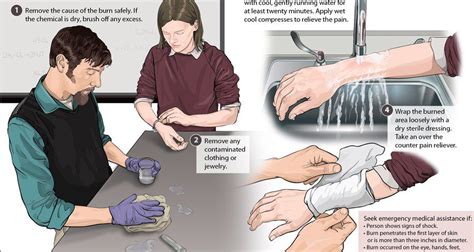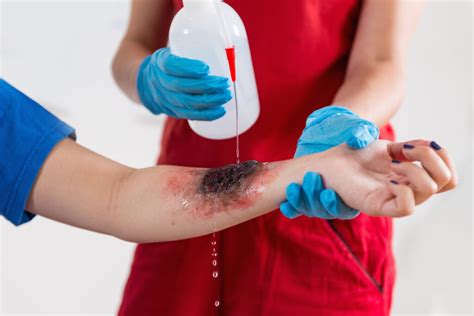Intro
Learn how to treat chemical burns effectively with our expert guide. Discover 7 evidence-based methods to alleviate pain, reduce scarring, and promote healing. From immediate first aid to long-term care, we cover it all. Get the best treatment for chemical burns, including acid burns, alkali burns, and more.
Chemical burns, also known as caustic burns, are a type of burn caused by chemical substances that can cause damage to the skin, eyes, and other tissues. These burns can be extremely painful and potentially life-threatening if not treated promptly and effectively. In this article, we will discuss seven ways to treat chemical burns effectively.
Chemical burns can occur in various settings, including the workplace, home, and laboratory. The severity of the burn depends on the type of chemical, the concentration of the chemical, and the duration of exposure. It is essential to take immediate action when a chemical burn occurs to minimize the damage and promote healing.

Understanding Chemical Burns
Before we dive into the treatment options, it is crucial to understand the different types of chemical burns and their effects on the body. Chemical burns can be categorized into three main types:
- Alkaline burns: These burns are caused by substances with a high pH level, such as sodium hydroxide, calcium hydroxide, and potassium hydroxide. Alkaline burns can penetrate deep into the skin and cause severe damage.
- Acid burns: These burns are caused by substances with a low pH level, such as sulfuric acid, hydrochloric acid, and nitric acid. Acid burns can cause extensive damage to the skin and underlying tissues.
- Organic solvent burns: These burns are caused by substances such as gasoline, kerosene, and turpentine. Organic solvent burns can cause damage to the skin and underlying tissues.
7 Ways to Treat Chemical Burns Effectively
1. Flush the Affected Area
The first step in treating a chemical burn is to flush the affected area with water. Remove any contaminated clothing or jewelry, and rinse the area with cool or lukewarm water for at least 15-20 minutes. This helps to neutralize the chemical and prevent further damage.

2. Remove Contaminated Clothing
Remove any contaminated clothing or jewelry from the affected area. This helps to prevent further irritation and promotes healing. Cut off clothing that is stuck to the skin, and avoid pulling or tugging on the affected area.
3. Apply a Topical Cream or Gel
Apply a topical cream or gel to the affected area to help soothe and calm the skin. Look for creams or gels that contain ingredients such as aloe vera, silver sulfadiazine, or hydrocortisone. These ingredients can help reduce inflammation, promote healing, and prevent infection.

4. Take Pain Relief Medication
Chemical burns can be extremely painful. Take pain relief medication such as acetaminophen or ibuprofen to help manage pain and discomfort. However, always follow the recommended dosage and consult with a doctor before taking any medication.
5. Apply a Non-Stick Dressing
Apply a non-stick dressing to the affected area to protect the skin and promote healing. Look for dressings that are breathable and moisture-wicking, such as those made from silicone or foam.

6. Monitor for Infection
Monitor the affected area for signs of infection, such as redness, swelling, increased pain, or pus. If you notice any of these symptoms, seek medical attention immediately.
7. Seek Medical Attention
Finally, seek medical attention if the chemical burn is severe or covers a large area of the body. A doctor can assess the burn and provide further treatment, including antibiotics, pain relief medication, and wound care.

Preventing Chemical Burns
Preventing chemical burns is always better than treating them. Here are some tips to prevent chemical burns:
- Wear protective clothing: Wear protective clothing, including gloves, goggles, and a face mask, when working with chemicals.
- Read labels carefully: Read labels carefully and follow instructions when using chemicals.
- Handle chemicals with care: Handle chemicals with care, and avoid splashing or spilling them.
- Keep chemicals out of reach: Keep chemicals out of reach of children and pets.
Conclusion
Chemical burns can be severe and potentially life-threatening if not treated promptly and effectively. By following the seven ways to treat chemical burns effectively, you can minimize the damage and promote healing. Remember to always wear protective clothing, read labels carefully, and handle chemicals with care to prevent chemical burns.
FAQs
What are the symptoms of a chemical burn?
+The symptoms of a chemical burn include redness, swelling, blisters, pain, and difficulty breathing.
How can I prevent chemical burns?
+Preventing chemical burns involves wearing protective clothing, reading labels carefully, handling chemicals with care, and keeping chemicals out of reach of children and pets.
What should I do if I experience a chemical burn?
+If you experience a chemical burn, flush the affected area with water, remove contaminated clothing, and seek medical attention if necessary.
